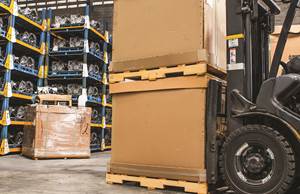EconCore and MEAF Partner in Specialized Lab Extruder Development
Check the latest in EconCore’s progress in the development of new all-thermoplastic continuous honeycomb cores.
In late March, I blogged about Belgium’s EconCore’s extended capabilities of its ThermHex technology to produce continuous honeycombs from several high-performance thermoplastics. Now the company has partnered with Holland’s MEAF Machines to develop and install a fully-functional laboratory-scale extrusion and forming line at the company’s recently-refurbished R&D facilities in Leuven, Belgium.
At the heart of the line is a purpose-built 50-mm extruder equipped with a special 500-mm sheet die built by Austrian flat-die specialist EMO Extrusion Molding. EconCore patented ThermHex technology produces honeycomb structures from a single continuous thermoplastic sheet. This involves a sequence of thermoforming, folding and bonding operations.
Cell size, density and thickness of the honeycombs can be altered with simple hardware and/or process parameter adjustments. The process allows for inline bonding of solid skins to one or both sides of the honeycomb, to create an extremely cost-effective finished composite panel.
Prior to the installation of the new purpose-built extruder, EconCore was carrying out its honeycomb developments using sheet unwound from a roll. “Now that we can produce our own sheet in-line, we have more flexibility in our operations and it is obviously much easier to make changes to the material formulations,” says technical manager Wouter Winant. EconCore and MEAF collaborated closely on the design of the laboratory extruder, which is equally capable of processing polyolefins, bioplastics and high-performance thermoplastics such as PC, nylons and PPS.
Explains Winant, “This is a non-typical set-up, but it is very important for our development work. EconCore already has licensees around the world producing continuous honeycombs and honeycomb-cored laminates in polyolefins—predominantly polypropylene—and we intend to continue refining the process technology for these materials. The new line is partly intended for this purpose. At the same time though, we are extending the potential of ThermHex technology by enabling it to be used with thermoplastics with superior mechanical and thermal performance—what we call HPTs. Normally this would require the use of a second extruder, since the processing characteristics of polyolefins are quite different from those of HPTs. But with this purpose-designed extruder, we have so far managed to obtain excellent results on around 10 different kinds of polymers.”
The MEAF extruder has a 50-mm barrel holding a screw with an L:D of 34:1, which is typical for polyolefins. However, it also has a superior heating capability, with each of its five zones rated at 5.8 kW. Despite this high-power rating, the extruder is highly energy-efficient, in line with MEAF’s philosophy of creating extrusion systems with low carbon footprints. A 600-L dryer for hygroscopic materials is fully integrated into the production system. Maximum output from the extruder is around 150 kg/hr.
“We have been cooperating with MEAF for several years now, on various projects, and the results have always been very encouraging. Both our companies are small/medium-sized, with a flexible approach to getting things done, and a strong thirst for success, so we work together well,” says EconoCore’s COO Tomasz Czarnecki,
Czarnecki notes that licensees of the company’s ThermHex process have no obligation to use MEAF extruders, but often tend to decide to choose this option, as they are encouraged when seeing the results this equipment delivers. Adds Czarnecki, “The call for innovative, light-weighting material solutions is very loud while the cost-efficient processing within the integrated production process combined with cost savings linked to the product’s weight reduction and production energy-efficiency is at high demand. This generates the fuel for our developments. After successful commercial evolutions within the current, globally distributed network of our licensees in the sectors of industrial packaging, building, automotive as well as wider transportation and others, and with the new, exciting license projects in the pipeline, we intend to continue our cooperation to take ThermHex technology to the next level, amongst others with HPTs.”
Related Content
Scaling Up Sustainable Solutions for Fiber Reinforced Composite Materials
Oak Ridge National Laboratory's Sustainable Manufacturing Technologies Group helps industrial partners tackle the sustainability challenges presented by fiber-reinforced composite materials.
Read MoreGeneral Polymers Thermoplastics to Further Expand Distribution Business
NPE2024: Following the company’s recent partnership buyout, new North American geographic territories are in its sight.
Read MoreThe Fantasy and Reality of Raw Material Shelf Life: Part 1
Is a two-year-old hygroscopic resin kept in its original packaging still useful? Let’s try to answer that question and clear up some misconceptions.
Read MoreWhat's the Allowable Moisture Content in Nylons? It Depends: Part 2
Operating within guidelines from material suppliers can produce levels of polymer degradation. Get around it with better control over either the temperature of the melt or the barrel residence time.
Read MoreRead Next
Making the Circular Economy a Reality
Driven by brand owner demands and new worldwide legislation, the entire supply chain is working toward the shift to circularity, with some evidence the circular economy has already begun.
Read MoreBeyond Prototypes: 8 Ways the Plastics Industry Is Using 3D Printing
Plastics processors are finding applications for 3D printing around the plant and across the supply chain. Here are 8 examples to look for at NPE2024.
Read MoreFor PLASTICS' CEO Seaholm, NPE to Shine Light on Sustainability Successes
With advocacy, communication and sustainability as three main pillars, Seaholm leads a trade association to NPE that ‘is more active today than we have ever been.’
Read More


























